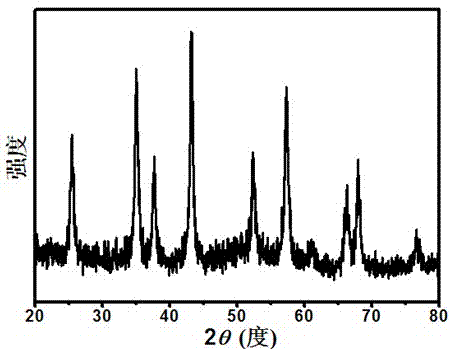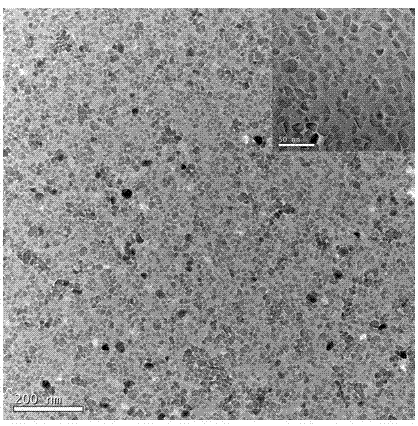Method for preparing completely dispersed alpha aluminum oxide nano particles
A technology of α-alumina and nano-particles, which is applied in the field of inorganic materials, can solve the problems of large particle size, high phase transition temperature, and poor dispersion, and achieve the effect of small size, low calcination temperature, and good dispersion
- Summary
- Abstract
- Description
- Claims
- Application Information
AI Technical Summary
Problems solved by technology
Method used
Image
Examples
Embodiment 1
[0017] According to the molar ratio of iron ions and aluminum ions at 5:1 and the concentration of aluminum ions at 0.02 mol / L, appropriate amounts of aluminum nitrate and iron nitrate were weighed and dissolved in deionized water. Then titrate the mixed solution to pH 7 with 3 mol / L ammonia water, and continue to stir for 0.5 h. The precipitate was filtered, washed with deionized water and absolute ethanol, and dried at 60°C to obtain the precursor. The precursor was put into a tube furnace, calcined to 620 °C at a rate of 3 °C / min, kept for 2 h, and cooled naturally. The calcined powder was corroded in a reaction kettle with 4 mol / L hydrochloric acid at a temperature of 100°C. Finally, the remaining precipitates in the reactor were washed by centrifugation with 4 mol / L hydrochloric acid and absolute ethanol, respectively, to obtain α-alumina nanoparticles.
[0018] The obtained α-alumina nanoparticles have an average particle size of 14 nm, a particle size distribution of ...
Embodiment 2
[0020] According to the molar ratio of iron ions and aluminum ions at 5:1 and the concentration of aluminum ions at 0.02 mol / L, appropriate amounts of aluminum nitrate and iron nitrate were weighed and dissolved in deionized water. Then titrate the mixed solution to pH 7 with 3 mol / L ammonia water, and continue to stir for 0.5 h. The precipitate was filtered, washed with deionized water and absolute ethanol, and dried at 60°C to obtain the precursor. The precursor was put into a tube furnace, calcined to 660 °C at a rate of 3 °C / min, kept for 2 h, and cooled naturally. The calcined powder was corroded in a reaction kettle with 4 mol / L hydrochloric acid at a temperature of 100°C. Finally, the remaining precipitates in the reactor were washed by centrifugation with 4 mol / L hydrochloric acid and absolute ethanol, respectively, to obtain α-alumina nanoparticles.
[0021] The obtained α-alumina nanoparticles have an average particle size of 23 nm, a particle size distribution of ...
Embodiment 3
[0023] According to the molar ratio of iron ions and aluminum ions at 7:1, and the concentration of aluminum ions at 0.02 mol / L, appropriate amounts of aluminum nitrate and iron nitrate were weighed, and dissolved in deionized water. Then titrate the mixed solution to pH 7 with 3 mol / L ammonia water, and continue to stir for 0.5 h. The precipitate was filtered, washed with deionized water and absolute ethanol, and dried at 60°C to obtain the precursor. The precursor was put into a tube furnace, calcined to 660 °C at a rate of 3 °C / min, kept for 2 h, and cooled naturally. The calcined powder was corroded in a reaction kettle with 4 mol / L hydrochloric acid at a temperature of 100°C. Finally, the remaining precipitates in the reactor were washed by centrifugation with 4 mol / L hydrochloric acid and absolute ethanol, respectively, to obtain α-alumina nanoparticles.
[0024] The obtained α-alumina nanoparticles have an average particle size of 25 nm, a particle size distribution o...
PUM
| Property | Measurement | Unit |
|---|---|---|
| size | aaaaa | aaaaa |
| particle size | aaaaa | aaaaa |
| particle size | aaaaa | aaaaa |
Abstract
Description
Claims
Application Information
 Login to view more
Login to view more - R&D Engineer
- R&D Manager
- IP Professional
- Industry Leading Data Capabilities
- Powerful AI technology
- Patent DNA Extraction
Browse by: Latest US Patents, China's latest patents, Technical Efficacy Thesaurus, Application Domain, Technology Topic.
© 2024 PatSnap. All rights reserved.Legal|Privacy policy|Modern Slavery Act Transparency Statement|Sitemap


